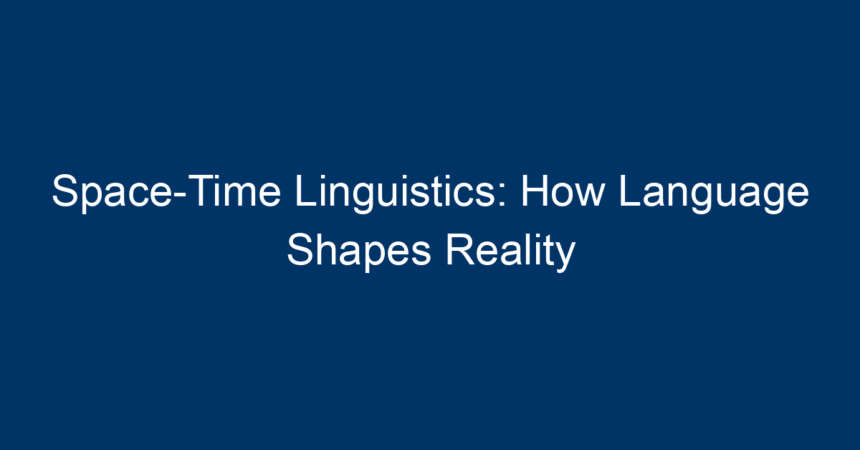Introduction
Language is more than just a tool for communication; it is a lens through which we perceive and interpret the world around us. This idea is at the heart of space-time linguistics, a fascinating intersection of linguistics, philosophy, and cognitive science. In this article, we’ll explore how the structure and nuances of languages influence our understanding of time, space, and reality itself. We’ll delve into the science behind this concept, providing you with actionable insights on how language shapes not just our thoughts but our very perception of reality.
What is Space-Time Linguistics?
At its core, space-time linguistics examines the relationship between language, time, and space. This field argues that the way we use language can mold our understanding of temporal and spatial concepts. Researchers in this area suggest that language isn’t just a passive representation of the world; it actively shapes the way we think and interact with our environments.
The Linguistic Relativity Hypothesis
One key aspect to understanding space-time linguistics is the linguistic relativity hypothesis, often associated with Benjamin Lee Whorf and Edward Sapir. This hypothesis posits that the structure of a language affects its speakers’ worldview and cognition. For example, consider how different languages encode time:
- English tends to treat time linearly—past, present, future.
- Hopi, a Native American language, does not use a fixed time structure, focusing instead on the nature of actions.
Such linguistic differences can lead to profound variations in how speakers of different languages conceptualize time and existence, impacting everything from daily tasks to philosophical outlooks.
Language as a Cognitive Tool
The exploration of space-time linguistics includes examining how language acts as a cognitive tool that structures our thoughts. When we engage with abstract concepts like time and space, we often rely on language to create mental frameworks. For example, phrases like “running out of time” or “moving forward in life” shape our understanding of time as a commodity that can be measured and managed.
The Role of Temporal Expressions
Understanding Time Through Language
Temporal expressions in language serve as anchors to help us navigate our experiences. Tenses and temporal adverbs dictate how we perceive the passage of time. Different cultures utilize unique ways of discussing time:
- Tense Markers: In English, verb conjugations differentiate between past, present, and future.
- Aspectual Information: Some languages, like Russian, allow speakers to convey the nature of actions (completed, ongoing, etc.) through distinct verb forms.
These variations reveal how deeply intertwined our experience is with the linguistic structures we use. To fully grasp these complexities, it’s useful to explore how spatial terms also relate to our understanding of time.
Spatial Language and Time Perception
Spatial concepts often intermingle with our perception of time. Consider common expressions that involve spatial metaphors:
- “Looking forward to the weekend”
- “Time flies when you’re having fun”
These phrases illustrate how we conceptualize future events as “ahead” and past events as “behind.” This spatialization of time indicates that our cognitive mapping of temporal experiences is intrinsically linked to spatial understanding.
Cross-Cultural Perspectives on Time and Space
Time Perspectives in Different Cultures
The cultural context of language can dramatically influence our temporal perceptions. Various cultures have their unique ways of organizing time. For example:
- In many Western cultures, time is viewed as a commodity, leading to stringent schedules and deadlines.
- Conversely, some Indigenous cultures adopt a more cyclical approach to time, emphasizing events and relationships over strict deadlines.
Languages encapsulate these differing philosophies, affecting how individuals relate and communicate their experiences of time.
The Influence of Language on Technology and Science
As technological advancements continue to evolve, the language we use also adapts. The terminology surrounding new technologies can shape our perceptions and expectations. Take, for instance, the rise of digital communication tools:
- The phrase “time-stamped” creates a specific way of understanding digital interactions, framing them as part of a broader narrative connected through time.
Understanding technological language through the lens of space-time linguistics can provide insights into how these advancements alter our social constructs of time and space, as well.
Practical Applications of Space-Time Linguistics
Language Learning and Cultural Awareness
Understanding the concepts of space-time linguistics can greatly enhance language learning. By recognizing how different languages treat time and space, learners can adapt their thinking and perceptions accordingly. This not only makes the process more engaging but also fosters deeper cultural appreciation.
Enhancing Communication in Global Contexts
In an increasingly interconnected world, effective communication across cultures is more important than ever. Understanding the nuances of space-time linguistics can help professionals navigate international business or diplomacy. By being aware of linguistic differences in interpreting time and space, communicators can avoid misunderstandings and foster collaboration.
Personal Development and Mindfulness
The insights drawn from space-time linguistics can enrich personal development. By reflecting on how language shapes our thoughts and perceptions, individuals can cultivate a more mindful approach to their experiences. For instance, reframing thoughts about time from a linear to a more flexible perspective can reduce stress levels and promote a more serene outlook on life.
Conclusion
Space-time linguistics offers a profound understanding of the intricacies between language, time, and space. By comprehending how linguistic structures can shape our perceptions and cognitive frameworks, we can improve communication, gain cultural awareness, and enhance personal growth.
Actionable Insights
-
Engage with Different Languages: Explore how various languages express time and space. Consider learning a new language as a way to broaden your cognitive framework.
-
Mindful Language Use: Pay attention to the language you use day-to-day. Consider how certain phrases and terms influence your perceptions of time and your reality.
- Foster Cultural Awareness: Be open to diverse temporal and spatial constructs when interacting with people from different cultural backgrounds. This openness can enrich your understanding of their experiences.
In essence, by recognizing the powerful role of language in shaping our reality through the lens of space-time linguistics, we can better navigate our lives and interactions in an increasingly complex world.




